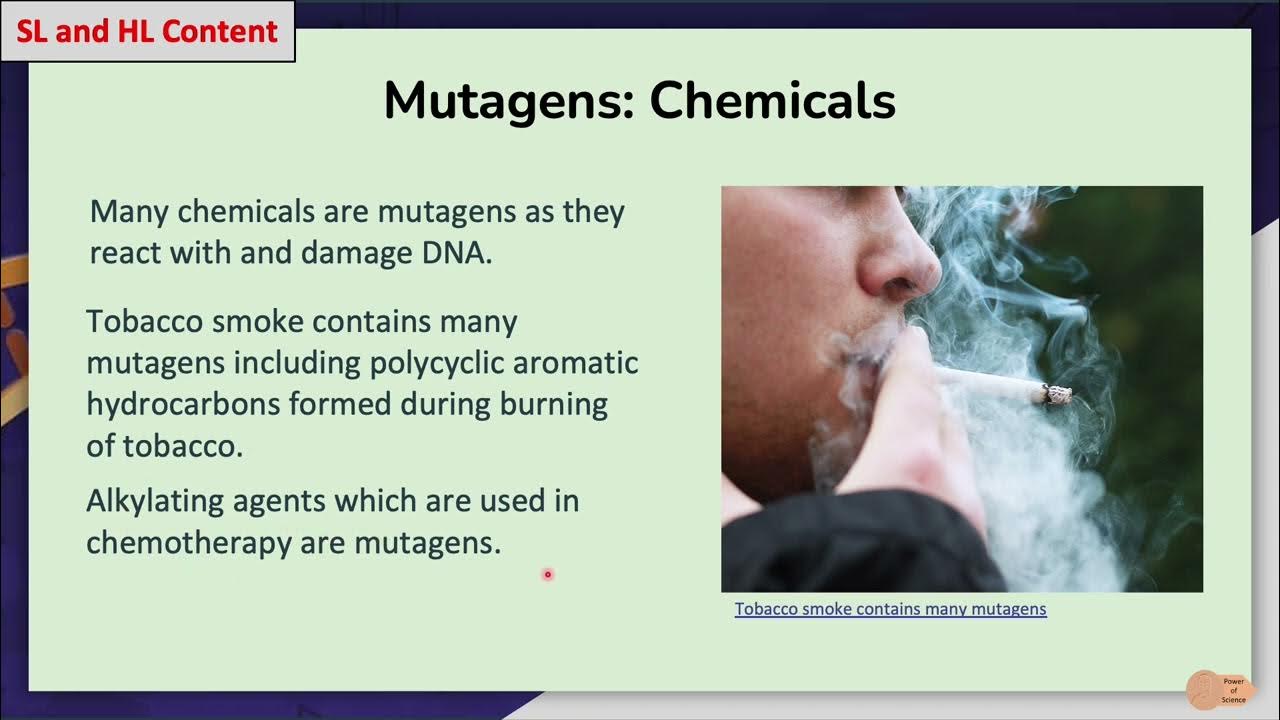Apa saja jenis Mutagen??
Summary
TLDRThis video explores the various types of mutagens that cause mutations in DNA, including physical, chemical, biological, and metal-based mutagens. It covers the effects of radiation (X-rays, UV, gamma rays), chemical agents (free radicals, aromatic compounds), biological factors (viruses, bacteria), and metals like arsenic and chromium. Through engaging examples, such as the Chernobyl disaster and the role of melanin in skin protection, the video highlights how these mutagens can lead to genetic changes, diseases, and even cancer. Viewers are encouraged to understand the importance of avoiding mutagen exposure for better health.
Takeaways
- 😀 Mutagens are agents that cause changes in DNA, which can lead to mutations. These can be categorized into physical, chemical, biological, and metallic types.
- 😀 Physical mutagens include ionizing radiation (X-rays, Gamma rays, UV radiation), which can cause mutations by ionizing molecules in DNA, leading to cell damage and potential cancer.
- 😀 X-rays (Rontgen) can penetrate body tissues and cause genetic mutations, which is why their use in medicine is regulated to avoid excessive exposure.
- 😀 Gamma rays, similar to X-rays, have high energy and can penetrate deep into cells, potentially causing severe genetic damage and mutations.
- 😀 UV radiation from sunlight can cause skin mutations, with UVB linked to skin cancer. Skin pigmentation (melanin) plays a protective role against UV damage.
- 😀 Radioactive exposure, such as from nuclear accidents like Chernobyl, can result in long-term mutations in both plants and animals, including humans.
- 😀 Chemical mutagens, like free radicals, aromatic compounds (e.g., benzene), and hydrocarbons, can damage DNA, leading to mutations or cancer.
- 😀 Free radicals are produced during cellular respiration and can damage DNA unless neutralized by antioxidants or enzymes like catalase.
- 😀 Biological mutagens include viruses and bacteria. For example, the Human Papillomavirus (HPV) can cause genetic mutations in infected host cells, potentially leading to cancer.
- 😀 Heavy metals, such as arsenic, chromium, nickel, and cobalt, are mutagenic and carcinogenic. They can damage DNA and disrupt cellular functions, increasing cancer risks.
- 😀 The body has DNA repair mechanisms to fix minor mutations, but excessive exposure to mutagens can overwhelm these defenses, leading to permanent genetic changes and diseases like cancer.
Q & A
What are mutagens and how do they affect organisms?
-Mutagens are agents that cause mutations in the DNA of organisms. These mutations can lead to genetic changes that might affect the organism's traits or lead to diseases such as cancer.
What types of mutagens were discussed in the video?
-The video discusses four main types of mutagens: physical mutagens (like ionizing radiation), chemical mutagens (such as free radicals and aromatic compounds), biological mutagens (including viruses and bacteria), and metal-induced mutagens (e.g., arsenic, chromium, and nickel).
How does ionizing radiation cause mutations?
-Ionizing radiation, such as X-rays and gamma rays, can penetrate cells and damage their DNA. This damage can result in mutations that may lead to cancer or other genetic disorders.
Why is ultraviolet (UV) radiation considered a mutagen?
-UV radiation has high energy that can ionize DNA within skin cells, leading to mutations. Prolonged exposure to UV can cause skin damage, premature aging, and an increased risk of skin cancer.
What is the role of melanin in protecting against UV radiation?
-Melanin is a pigment in the skin that helps protect against UV radiation. People with higher melanin levels have greater protection from UV damage, which is why individuals from regions with high sun exposure, like Africa, tend to have darker skin.
What were some of the effects of the Chernobyl nuclear disaster on living organisms?
-The Chernobyl nuclear disaster caused widespread radiation exposure, leading to genetic mutations in plants, animals, and humans. Examples include deformed birds, mutated foxes, and slower-growing trees. It also caused long-term health concerns, such as cancer and birth defects.
What are free radicals, and how do they contribute to mutagenesis?
-Free radicals are unstable molecules that can be generated during cellular processes like respiration. They can damage DNA by reacting with it, leading to mutations. One example is hydrogen peroxide, which is toxic to cells and requires the enzyme catalase to break it down.
How can chemical compounds like benzene act as mutagens?
-Benzene and other aromatic compounds can be mutagenic due to their ability to interact with DNA, potentially causing changes in the genetic material that may lead to cancer or other genetic disorders.
How do viruses and bacteria contribute to genetic mutations?
-Viruses can inject their genetic material into host cells, altering the host's DNA. Some bacteria, when infected by viruses, can pass viral genetic material to human cells, leading to double genetic damage.
What is the effect of metal exposure on DNA?
-Certain metals, such as arsenic, chromium, and nickel, can act as mutagens by interacting with DNA and disrupting normal cellular processes. These metals are often carcinogenic and can cause mutations leading to cancer and other genetic diseases.
How does the body protect itself from mutagens?
-The body has natural mechanisms for repairing DNA, such as enzymes that correct mutations. However, if mutagens damage the DNA coding regions (which produce proteins), the mutations can be visible in physical traits or lead to diseases like cancer.
What is the importance of understanding mutagens and their effects?
-Understanding mutagens is crucial for protecting against genetic damage, improving public health, and developing strategies to prevent diseases like cancer. It also helps people make informed decisions about their exposure to environmental and chemical risks.
Outlines

此内容仅限付费用户访问。 请升级后访问。
立即升级Mindmap

此内容仅限付费用户访问。 请升级后访问。
立即升级Keywords

此内容仅限付费用户访问。 请升级后访问。
立即升级Highlights

此内容仅限付费用户访问。 请升级后访问。
立即升级Transcripts

此内容仅限付费用户访问。 请升级后访问。
立即升级5.0 / 5 (0 votes)






